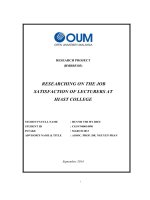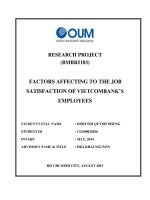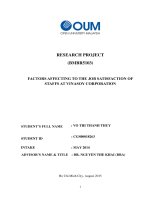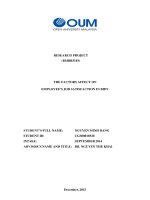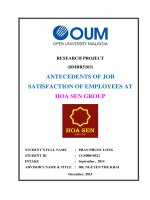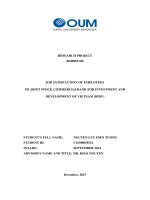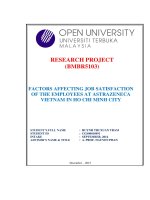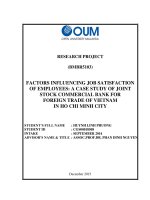Job satisfaction of underwriting management employees at baoviet insurance
Bạn đang xem bản rút gọn của tài liệu. Xem và tải ngay bản đầy đủ của tài liệu tại đây (1.87 MB, 93 trang )
ĐẠI HỌC QUỐC GIA HÀ NỘI
KHOA QUẢN TRỊ VÀ KINH DOANH
---------------------
PHẠM THU ANH
JOB SATISFACTION OF UNDERWRITING
MANAGEMENT EMPLOYEES AT BAOVIET INSURANCE
ĐO LƯỜNG MỨC ĐỘ HÀI LÒNG TRONG CÔNG VIỆC
CỦA CÁN BỘ TRỤ SỞ CHÍNH - TỔNG CÔNG TY
BẢO HIỂM BẢO VIỆT
LUẬN VĂN THẠC SĨ QUẢN TRỊ KINH DOANH
Hà Nội - 2017
ĐẠI HỌC QUỐC GIA HÀ NỘI
KHOA QUẢN TRỊ VÀ KINH DOANH
---------------------
PHẠM THU ANH
JOB SATISFACTION OF UNDERWRITING
MANAGEMENT EMPLOYEES AT BAOVIET INSURANCE
ĐO LƯỜNG MỨC ĐỘ HÀI LÒNG TRONG CÔNG VIỆC
CỦA CÁN BỘ TRỤ SỞ CHÍNH - TỔNG CÔNG TY
BẢO HIỂM BẢO VIỆT
Chuyên ngành: Quản trị kinh doanh
Mã số: 60 34 01 02
LUẬN VĂN THẠC SĨ QUẢN TRỊ KINH DOANH
NGƯỜI HƯỚNG DẪN KHOA HỌC: TS. TRẦN HUY PHƯƠNG
Hà Nội - 2017
DECLARATION
The author confirms that the research outcome in the thesis is the result of
author’s independent work during study and research period and it is not yet published in
other’s research and article.
The other’s research result and documentation (extraction, table, figure, formula,
and other document) used in the thesis are cited properly and the permission (if required) is
given.
The author is responsible in front of the Thesis Assessment Committee, Hanoi
School of Business and Management, and the laws for above-mentioned declaration.
Date 01/10/2017
i
ACKNOWLEDGEMENT
First of all, I would like to express my sincere gratitude to PhD. Tran Huy
Phuong, my research supervisor, for his invaluable guidance and advice in helping me
following the right track throughout the course of my research work. I am also grateful to
my committee member who have given their suggestions and comments for improvement
of this research study. I take the responsibility of possible mistakes and errors in this study.
Secondly, I would like to send my great thanks to professors, lecturers and staffs at
the Hanoi School of Business and Management for the knowledge and experience that
have been shared through their lectures during the program.
Thirdly, I am very thankful to the senior management team and my colleagues in
Underwriting Management departments at BaoViet Insurance for their kind cooperation
and support to let me interview them and also gave me very useful information as well as
valuable experiences.
Last but not least, I would like to say many thanks to my family and friends for
giving me encouragement and supports during my studying time and completion of this
thesis.
Hanoi, October 2017
PHAM THU ANH
ii
TABLE OF CONTENT
ACKNOWLEDGEMENT .......................................................................................... i
ABBREVIATION ..................................................................................................... vi
LIST OF TABLES .................................................................................................. viii
LIST OF FIGURES.................................................................................................. vii
INTRODUCTION .......................................................................................................1
CHAPTER 1THEORETICAL FRAMEWORK ON JOB SATISFACTION OF
EMPLOYEES IN ORGANIZATION ........................................................................7
1.1.Definition job satisfaction ..................................................................................7
1.1.1. Definition of job satisfaction ......................................................................7
1.1.2. The role of job satisfaction ........................................................................8
1.2.Job descriptive index to measure job satisfaction ............................................10
CHAPTER 2 JOB SATISFACTION OF UNDERWRITING MANAGMENT
EMPLOYEES AT BAOVIET INSURANCE ..........................................................14
2.1. Overview of BaoViet Insurance Corporation and Underwriting Management
Division ..................................................................................................................14
2.1.1. Introduction of BaoViet ...........................................................................14
2.1.2. The feature and structure of Underwriting Management (UM) Division in
BaoViet Insurance (BVI).......................................................................................16
2.2.Dimensions to measure job satisfaction of UM employees at BVI .................18
2.3.Respondent profile and scale reliability ...........................................................21
2.3.1. Respondent profile ...................................................................................21
2.3.2. Exploration factor analysis (EFA) for dimension and attribute of
measuring job satisfaction ..................................................................................24
iii
2.3.3. Testing reliability for dimension and attribute of measuring job
satisfaction ..........................................................................................................25
2.4.Analyzing the situation of UM employees job satisfaction at BVI: ................27
2.4.1. Satisfaction with “Salary”........................................................................27
2.4.2. Satisfaction with“Work itself”.................................................................28
2.4.3. Satisfaction with“Training, promotion” ..................................................30
2.4.4. Satisfaction with“Manager” ....................................................................31
2.4.5. Satisfaction with “Colleague” .................................................................32
2.4.6. Satisfaction with “Welfare” .....................................................................34
2.4.7. Satisfaction with “Working environment” ..............................................36
2.5.Overall assessment for UM employees’ job satisfaction at BVI .....................37
2.5.1. Overall job satisfaction of UM employees at BVI .................................37
2.5.2. Analyzing dimensions to measure job satisfaction through regression
model. .................................................................................................................41
CHAPTER 3 SOLUTIONS TO IMPROVEUNDERWRITINGMANAGEMENT
EMPLOYEES’ JOB SATISFACTION AT BAOVIET INSURANCE ...................46
3.1. Human resources development strategy and job satisfaction improvement goal ...46
3.1.1. Human
resources
development
strategy
of
the
Underwriting
Management division at BVI ..............................................................................46
3.1.2. Employees’ job satisfaction improvement goal.......................................47
3.2.Solutions to improve underwriting management employees’ job satisfaction at
BVI .........................................................................................................................49
3.2.1. Implementing training programs and expanding the promotion
opportunities to develop underwriting management employees’ capabilities and
skills. .................................................................................................................49
iv
3.2.2. Improving the working environment positively ......................................52
3.2.3. Improving policies on Salary and Welfare ..............................................56
3.2.4. Improving the factor of manager: ............................................................58
3.2.5. Improving activities to connect “Colleagues” .........................................60
3.3.Recommendations for the solutions .................................................................61
3.3.1. Recommendations for the Company .......................................................61
3.3.2. Recommendations for managers .............................................................62
3.3.3. Recommendations for employees ............................................................62
CONCLUSION .........................................................................................................65
REFERENCE LIST ..................................................................................................66
APPENDIXES ..........................................................................................................68
v
ABBREVIATION
1. AJDI:
Adjusted Job descriptive Index
2. BVI:
BaoViet Insurance Corporation
3. EFA:
Exploration factor analysis
4. HR:
Human resource
5. JDI:
Job descriptive Index
6. UM:
Underwriting Management
vi
LIST OF FIGURES
Figure 1.1: Research process ................................................................................................. 4
Figure 3.1: Revenue of BaoViet Insurance from 2009 – 2013 ............................................ 15
Figure 3.2: Market share of BaoViet Insurance ................................................................... 16
Figure 3.3: Organization Chart of BaoViet Insurance ......................................................... 17
Figure 3.4: Organization Chart of Underwriting Management Division ................................ 18
Figure 3.5: AJDI model studying employees’ job satisfaction ............................................ 20
Figure 3.6: Structure of surveyed sample according to “Age” ............................................ 23
Figure 3.7: Structure of surveyed sample according to “Qualification”.............................. 23
Figure 3.8: Structure of surveyed sample according to “Seniority” .................................... 24
Figure 3.9: Adjusted research model ................................................................................... 25
vii
LIST OF TABLES
Table 3.1: Dimensions of job satisfaction ........................................................................... 20
Table 3.2: The sample description ....................................................................................... 22
Table 3.3: The result of Exploration factor analysis ............................................................ 25
Table 3.4: The result of the scale reliability ........................................................................ 26
Table 3.5: Satisfaction with“Salary and Welfare” ............................................................... 27
Table 3.6: Satisfaction with“Work itself and Working environment” ................................ 28
Table 3.7: Satisfaction with“Training, promotion and Decision-making right” ................. 30
Table 3.8: Satisfaction with“Manager” ............................................................................... 31
Table 3.9: Satisfaction with “Colleague” ............................................................................ 32
Table 3.10: Overall job satisfaction ..................................................................................... 37
Table 3.11: Job satisfaction based on each personal attribute ............................................. 39
Table 3.12: Results obtained by Annova analysis ............................................................... 41
Table 3.13: Correlation coefficient R2 ................................................................................. 42
Table 3.14: Coefficients ....................................................................................................... 43
viii
INTRODUCTION
1. Rationale
Job satisfaction is an attitude that is simply how content an individual is with his or
her job; whether he or she likes the job or individual aspects or facets of job. The
researcher shows that people learn from their environments and the corporate human
resource (HR) factors such as Pay or total compensation, the work itself, promotion
opportunities, relationship with supervisor, interaction and work relationship with
coworkers etc play a large part in creating job satisfaction. A worker's level of job
satisfaction can impact her job performance as well as the functioning, activities and
effectiveness of the organization's business. High levels of job satisfaction may be sign of a
good emotional and mental state of employees. It will result in positive behavior and vice
versa. The employees will try their best to dedicate for the job, increase positive outcomes,
decrease absenteeism and turnover. In the contrast, dissatisfaction from the work will result
in negative behavior of employees.
In any organization, employees are the key important factor to help companies
compete and retain in a market.When the Vietnamese economy develop more and more,
the requirements of HR become more important. The enterprises not only pay attention at
recruitment the right person for each position, but also know how to promote the staff
efforts, retain the skillful people and attract highly qualified manpower. When the
competitiveness of salary, working conditions, preferential regime between the enterprises
is happening commonly, theskilled and well trained staff retention and stable staffing
situation are now becoming the main problem that the business owners are interested. The
previous studies in the past suppose one of the most important factors that make employees
staying longer with company is the job satisfaction.
Being the first insurance company, BaoViet Insurance Corporation (BVI) has a
long heritage in Vietnam. With strong financial capability and an extensive network of 67
subsidiaries in 65 provinces of Vietnam, BVI has given local expertise in offering a
diversified range of non – life insurance products and services that meet the changes of
customers’ demand. By that way, the company has already maintained his leading position
in the insurance market with many significant achievements in terms of revenue, profit,
products and services quality.
1
The underwriting management (UM) division is one of the functional divisions of
BaoViet Insurance, with 40% labor force. It plays an important role to help the system
operate fluently, increase the competitiveness in the exploiting the insurance business and
ensure the effectiveness of BVI performance. The labor productivity and job efficiency of
Underwriting Management employees will also affect to the business performance of each
branches in particular and BVI in general. However, in recent years, the number and
frequency of resignation or work transfer of Underwriting Management employees tend to
be increasing. In order to get more insights into the workplace scenario and evaluateif
employees are actually satisfied with the work they do, it will be necessary to study of
Underwriting Management employee’s job satisfaction atBVI.The job satisfaction of
employees will make their work more interesting, reduce their stress, progressively
increase their confidence in their own competence and enhance commitment with the
company. It also decides the sustainable development of the organization. It helps the
companies avoid the big fluctuation of HR, and establish the HR management policies and
working environment more suitable to increase the job satisfaction of employees.
To be aware of the above problem importance, the topic “Job satisfaction of
Underwriting Management employees in BaoViet Insurance” is chosen to study
Underwriting
Managementemployees'
level
of
job
satisfactionand
give
some
recommendations to increase the job satisfaction, the retention of skillful personnel and
attract more highly qualified manpower to meet the job requirements of Underwriting
Management division - BVI.
2. Aims of research
In order to research and evaluate the job satisfaction of Underwriting Management
employees in BVI, the objectives of the study have been given as follows:
• Clarify the dimensions to measure the Underwriting Management employees’ job
satisfaction at BVI.
• Analyze the current status of Underwriting Management employees’ job satisfaction
at BVI.
• Propose some solutions and recommendations to improve the Underwriting
Management employee’s job satisfaction BVI.
In order to archive the above objectives, the research is to answer the following
questions:
2
What are the dimensions to measure employee’s job satisfaction?
How is the current job satisfaction of UM employees in BVI?
How to improve the job satisfaction of UM employees in BVI?
3. Objects of this research
The thesis focuses on job satisfaction of Underwriting Management employees in BVI.
4. Research scope
- Geographical Scope: The survey conducted in Underwriting Management
Division – BVI in Hanoi including employees of 6 departments: Fire & Engineering, Hull
& Cargo, Health &Personal Accident, Motors, Reinsurance, and Claim Department.
- Timing:
• Primary data: collected within 2 months April – May 2016
• Secondary data: collected from the company HR documents, reports and related
analysis in the period 2012 –2016
3
5. Research Methodology
5.1 Research process
Analyze secondary data:
Job Description
Company
report, Job
Description, and others
Theoretical of employee’s job
satisfaction
Dimension to measure job satisfaction
Interview
Interview
Survey
Analyze the job satisfaction of Underwriting
management employees in BVI
Solution to improve the Underwriting management
employee's job satisfaction
at BVI
Figure 1.1: Research process
(Source: Author’s data)
a. Data collection
i. Secondary data
Secondary datacollected from the below:
The data from textbooks and the internet provided the author with theories and
basic dimension to measure job satisfaction in the enterprises in general.
4
BVI reports, regulations, policies, Underwriting Management employees’ job
description: provided the author with information on the company’s turnover, market
share, the function and duties of UM Division, and HR policies applying currently in BVI.
ii. Primary data
Primary data collected from 2 methods:
a. Interview:
• Carried out the in-depth interview of 01 Deputy CEO and 05managers of UM division
with the open questions as below:
- The role and effect of Underwriting Management employees to the
humanresource of division
- The managers’ evaluation of the labor quality and working attitude of
Underwriting Management employees
- The interest of managers for employee’s satisfaction
- Orientation of HR development of the UM division in the future
• Carried out the direct interview of 6 UMemployees with the open questions as below:
- The working environment and pressure in the current job
- Current salary is paid in comparisonwith other insurance companies
- Opinion of welfare facilities in BaoViet Insurance
- Training and promotion opportunities of BaoViet Insurance for all the employees.
- The satisfaction level of delegation in the current job
- The job commitment to BaoViet Insurance
b. Survey:
*Respondents: Employees in Underwriting Management division including 06
departments:
Fire & Engineering department, Hull & Cargo department, Motor
department, Heath & Personal accident department, Reinsurance department, Claim
department.
*Sample size: UM department at Bao Viet Insurance has total 110 employees, so
all of them were choosen to study their satisfaction in working place with the questionnaire
designed by 2 sections:
♦First section: a measurement of the employees job satisfactionlevel ranging from 1
= Totally Disatisfied to 5 = Totally Satisfied with the 29 criterions basing on the 8 working
5
dimensions:Work itself, Trainning and promotion opportunities, Manager, Colleague,
Salary, Welfare, Working environment, Decision – making right
♦ Second section: personal attributes of surveyed participants.
-
Questionnaire distribution: via email
- Survey conducting:
+Pilot surveywas conducted with a random sample of15 staffs
-
chosen in UM division - BVI according to the favorable sampling method,by
delivering the preliminary questionnaires via email to be sure that it’s easyfor
15 employees to understand andtake part in this. Then, the results will be
collected to set up the formalquestionnaires.
+Official surveywas conducted with110UM employees in BVI by
-
delivering the formal questionnaires via email. 105 revoked with 100 full
required information, accounting for 90.9%of the sample.
b. Data analysis:
- Regarding the survey data, Microsoft Excelsoftware and the Mean method are
used to analyze the collected information. The inspection of scale, theriotical model and
hypothesis was carried out by the Crobach’s Alpha reliablity coefficient, Exploration factor
analysis, regression modelthrough SPSS software.
6. Research structure
The thesis is divided into three chapters as follows:
Chapter 1: Theoretical Framework on Job satisfaction of employee in organization
Chapter 2: Status of job satisfaction of Underwriting Management employees at
BVI.
Chapter 3: Solutions to improve the job satisfaction of Underwriting Management
employees in BaoViet Insurance.
6
CHAPTER 1
THEORETICAL FRAMEWORK ON JOB SATISFACTION OF EMPLOYEES IN
ORGANIZATION
1.1. Definition job satisfaction
1.1.1. Definition of job satisfaction
There are a lot of job satisfaction definition:
Spector (1997) refers to job satisfaction in terms of how people feel about their jobs
and different aspects of their jobs.This definition suggests job satisfaction is a general or
global affective reaction that individuals hold about their job.
Ellickson and Logsdon (2001) support this view by defining job satisfaction as the
extent to which employees like (satisfaction) or dislike (dissatisfaction) their jobs their
work.
Schermerhorn (1993) defines job satisfaction as an affective or emotional response
towards various aspects of an employee’s work. The author emphasizes that likely causes
of job satisfaction include status, supervision, co-worker relationships, job content,
remuneration and extrinsic rewards, promotion and physical conditions of the work
environment, as well as organizational structure. Similarly, Mc Namara (n.d.) points out
that job satisfaction refers to an individual’s feeling or state of mind giving heed to the
nature of the individual’s work. The author further explains that job satisfaction can be
influenced by a diversity of job dimensions, inter alia, the quality of the employee’s
relationship with their supervisor, the status of the physical environment in which the
individual works, degree of fulfillment in work.
Locke (1976), refer to job satisfaction as an individual’s mental state about the job.
Locked defined job satisfaction as “. . . a pleasurable or positive emotional state resulting
from the appraisal of one’s jobor job experiences.” Job satisfaction is the level of
contentment a person feels regarding his or her job. This feeling is mainly based on an
individual's perception of satisfaction. Job satisfaction can be influenced by a person's
ability to complete required tasks, the level of communication in an organization, and the
way management treats employees.
Job satisfaction is defined as "an individual's reaction to the job experience" (Berry,
1997). There are various components that are considered to be vital to job satisfaction.
These variables are important because they all influence the way a person feels about their
7
job. These components include the following: pay, promotion, benefits, supervisor, coworkers, work conditions, communication, safety, productivity, and the work itself. Each
of these factors figures into an individual's job satisfaction differently.
According to Bradley and Brian (2003), employee’s job satisfaction is pleasure that
an employee derives from his/her Job. It is an attitudinal variable that describe how people
feel about their job. Job satisfaction depends on balance between work role inputs (pain)like education, working time, effort, and work out puts(pleasures) like wages, fringe
benefits, status, task importance, working conditions, and intrinsic aspects of the job. If
work outputs (pleasures) are relative to work role inputs (pains).According the concept,
human has basic and universal needs and that, individual needs are fulfilled in their current
situation, and then that individual will be happy.
Hence, according to the author, the employee’s job satisfaction islevel of
contentment a person feels regarding his or her job. It can be influenced by a person's
abilityto complete required tasks, the level of communication in an organization, and the
way management treats to employees.Lower convenience costs, higher organizational and
social and intrinsic reward will increase job satisfaction. The employees will have pleasure,
happiness and positive attitude toward their job.
1.1.2. The role of job satisfaction
The human is always considered as the most important resource, the essential factor
that decides the success or failure in the business performance of the enterprises.
Human resources (HR), together with the advancements of science and technology,
are becoming the leading competitive factors of the company, especially in the context of
intellectual economy. Many of the companies have faced with the depletion of HR that
leads to reduce the motivation and productivity as well as lose the experienced staffs. The
managers of BaoViet Insurance always attend the quality of UM employees, then give
many solutions to reducerecruitment costs, increase retention of experienced staff and
motivate them to perform at a high level. Hence, how tomaintain and retain the appropriate
employees within the organization is the major concern of the managers.
One of the important variable to assess the HR management is the job satisfaction
of employees in the organization.In order for an organization to be productive, the
employees' concerns should be met. Several work motivation theories have corroborated
the implied role of job satisfaction. Work satisfaction theories, such as Maslow’s (1943)
8
Hierarchy of Needs, Hertzberg’s (1968) Two-Factor (Motivator-Hygiene) Theory, Locke’s
(1976) Range of Affect Theory, Bandura’s (1977) Social Learning Theory, and Landy’s
(1978) Opponent Process Theory, have tried to explain job satisfaction and its influence to
the behavior of the employees in the job by researching the theories.
- The employee has positive attitude in improving herself through daily job.
- The job satisfaction is the positive or negative motivation in the employees’
fulfillment. If a person is rewarded for high performance or stands to gain a reward for
doing the work, he/she may find the job more satisfying. The more satisfied an employee is
with their job, the more they will produce and the better feeling they will be.In contrast, the
negative indicators include absenteeism, sabotage, and violence will indicate low
commitment towards the organization and low job satisfaction.
In order for an organization to be successful they must continuously ensure the
satisfaction of their employees. Creating job satisfaction is the major priority of the
managers. Are the HR practice norms suitable for the labor? Is the job arrangement for the
employees reasonable for their ability? Is the job met the employees’ demand? Or what to
be equipped for the employees to do better at work etc. All this factors will decide the
positive/negative impact on their productivity and affect their decision whether or not they
will stay with their employersfor a relatively long period.
Accoring to Heskett et al (1994), creating job satisfaction plays an important role
an environmentthat allows the employees to increase the efficiency and productivity and
have strong commitment to put forth their best effort for the aim and mission of the
company.It’s also the way to build the loyalty of the employees to the organization, make
them get deeply involved in their jobs, and feel more enthusiastic when performing their
responsibilities in the workplace. In another research, happiness in the workplace leads to
much higher levels of productivity. It increases employee morale; therefore employees are
more willing to work harder to improve the company and its goalsthat are in line with their
own career goals and objectives, Derek R Allen & Merris Wilburn (2002).
The objectives of increasing job satisfaction:
- Make the work more interesting, reducing their stress, progressively increase their
confidence in their own competence, accept the responsibility and take steps to build on
their own satisfaction
9
- Increase the labor productivity, competitiveness and market expansion for the
enterprises businesses.
- Encourage the workers to always give their best shot in everything they do and
become more optimistic no matter what challenge we may face at work. In addition, a
person who is truly satisfied with his or her career life helps create a more positive working
environment. Workers who have job satisfaction can help boost the morale of his or her coemployees and will encourage them to be optimistic about their job.
1.2. Job descriptive index to measure job satisfaction
In simple terms, job satisfaction explains what makes people want to come to work.
What makes them happy about their job or not to quit their job? Their job satisfaction will
be further enhanced if they are doing work that is utilizing their skills.Job satisfaction is an
indicator of employee’s motivation to come to work and it changes with age and
employment cycle. Certain organizational characteristics influence job satisfaction, and
one of the major factors is the intrinsic nature of the job itself. An individual who
genuinely likes the content of the job will be more satisfied with the job.
As there are various measures to measure job satisfaction and not all of them could
be used at the same time, a choice had to be made. One of the most frequently used is the
Job Descriptive Index (JDI) developed by Smith, Kendall and Hulin (1969). When more
than one scale exists for any variable, it is better to use the measure that has a better
reliability and validity and is most frequently used.”
The Job Descriptive Index was chosen as the standard measure but at the same time
another section was added to measure the importance of the various dimensions to the
employees.
The Job Descriptive Index (JDI) (Smith, Kendall & Hulin, 1969) is the most widely
used measure of job satisfaction in existence today. JDI was designed to measure job
satisfaction through 5 aspects of a job: the work itself, salary, training / promotion
opportunities, manager and colleagues.
• The work itself: job specification such as projects, responsibilities. It relates to the
job challenges, the opportunities for applying personal abilities, an interesting feels
performing the tasks. The job satisfaction depends on the satisfaction with the work
components, such as the nature of job. The relevance of the work to workers is expressed
through many aspects of the nature of work: use of different skills, employees'
10
understanding the work process, and certain importance of the work for the organization.
In addition, the work must be in accordance with workers' capacity.
• Salary: relate to the employees awareness about thefair in paying the salary of the
company. A worker's level of job satisfaction can impact his/her job performance. The
performing employees feel satisfied with their job because of high-level or increased pay.
• Trainning / Promotion opportunities (i.e., job enlargement, more prestigious title):
relate to the employees awareness about the chances of trainning, individual ability
development and promotion in the organization.Advancement opportunities are believed to
have a positive influence job satisfaction. Kreitner and Kinicki (2001) supposed that
positive relationships between development opportunities and job satisfaction depend on
fairness perceptions of employees. Promotion opportunities have positive impact on job
satisfaction. In some studies in Vietnam (such as Tran Kim Dung, 2005; Ha Nam Khanh
Giao, 2011), the factor “promotion opportunities” is considered in aspects such as: Fully
professional trained, opportunities to improve the professional skills, create opportunities
for those who can afford, chance for individual developments, and training and promotion
policies are clear.
•Manager: relationship with the manager is the way in which subordinates perceive
a
supervisor's behavior can
positively
or
negatively
influence
job
satisfaction.
Communication behavior such as the facial expression, eye contact, vocal expression, and
body movement is crucial to the superior-subordinate relationship. Supervisor makes
employees satisfied through their communication, their attention and care for their
subordinates, or their act of protecting employees when it is necessary, and through
demonstrating their leadership ability and professional capacity in front of their staff
(Robins et al, 2002). In addition, employees feel satisfied with their supervisor thanks to
their fair treatment, or sincere recognition of employees' contribution. According to
Ramsey (1997), leadership affects working morale high or low. Attitudes and behaviors of
leaders for employees could also be factors affecting the behavior or uncooperative coworkers. The leadership style democracy creates more sympathy from employees. It can
promote learning and reduce the frustration in work when employees are motivated on
time. Many actual researches also show positive relationship between the factor
“supervisors” and job satisfaction.
11
• Colleagues: interaction and work relationship with co-workers relate to the
behaviors, co-workers relationship at working place.Colleagues are people working
together in the organization or the people working in the same department. Friendly coworker relation will increase the satisfaction with job of employees (Johns, 1996; Kreitner
& Kinicki in 2001). The factor “colleague” is considered good is in the organization,
employees are always willing to help each other, work together effectively, treat well,
working environment is friendly, and employees have reliable relations.
Besides that, in order to be suitable for the Vietnamese culture and society, basing
on the demand theory of Maslow and JDI of Smith, also the job characteristics of
departments in the UM division, the research will carry out the measurement of employees
job satisfaction and pointed out more 2 dimensions:
• Welfare: affect to the job satisfaction of employees. It covers both monetary and
nonmonetary fringe benefits. It includes benefit comparison with other organization. The
enterprises have a good wel-fare facilities that make the employees have higher level of job
satisfaction. Each company has different welfare facilities that are suitable for its structure
aparting from the common practices stipulated by the Goverment. That policies has been
implenmented well or badly depending on the activities of Trade union in that
organization. Therefore, it’s neccessary to create the combination of all functional
department smoothly to get the best results and increase the job satisfaction
• Working environment: employees can express their dissatisfaction or try to escape
the unpleasant aspects that they can meet. Employees will aware clearly the balance of job
dimensions in the working place with the time and pleasant. The employees will feel
satisfied working, consider the company as the second home and perform their task more
effectively.
The research will carry out the measurement of job satisfaction with 7 dimensions:
12
The work itself
Working
environment
Welfare
Salary
Job
satisfaction
Colleague
Manager
13
Training /
Promotion
opportunities
CHAPTER 2
JOB SATISFACTION OF UNDERWRITING MANAGMENT
EMPLOYEES AT BAOVIET INSURANCE
2.1.
Overview of BaoViet Insurance Corporation and Underwriting Management
Division
2.1.1. Introduction of BaoViet
BaoViet Insurance Corporation (BVI), being established in 1965, is a whollyowned subsidiary of BaoViet Holdings. The charter capital of BVI increased to VND2,000
billion in 2013 from VND1,800 billion in 2012; and reached VND 4,420 billion in early
2015. This increase of capital has made BVI being the non-life insurance company with
the largest chartered capital in the market, improved business performance, and driven
further developments in the future.
BVI has main product lines: medical, marine hull and cargo, motor, fire&
engineering insurance, aviation, and pilot agriculture insurance. Each business line
contributes 15% – 20% to total revenue and has a positive growth rate every year.
With over 50 years of establishment, BVI has grown dramatically: from a small
general insurance company first entering the Vietnam market in 1965 into one of the
largest insurance companies in the country with a network of 67 branches and nearly 300
customer support offices, employing more than 3,000 employees and 15,000 agents. BVI
is proud to be the first non-life insurer in Vietnam, and to be presented with many
prestigious awards by the State. BVI has played an increasingly important role in the
national economy and society:
• For customers, BVI has always stood from customers’ perspectives to serve their
increasingly sophisticated needs by providing comprehensive insurance products and
services. With the strong financial capacity, effective business management and claim
settlement, BVI enable to meet all insurance needs and handle claims of customers in a
prompt, timely and professional manner.
• For employees, BVI has built a performance-based culture, linked to a world class
performance management system and a competitive rewards structure, and continually
improved our recruitment, people training and development.
14
• For the community, BVI has strived to ensure we contribute to the peace of mind
and prosperity of society. Enhancing lives for the community where we operate is an
important part of how we run our business.
BVI’s business goals include improving customer service and the operation of the
call center to provide high quality product consultation and add values to customers;
developing individual insurance products with advanced features, especially medical and
health insurance, and automobile insurance; extend distribution channel including crossselling with BaoViet life, direct sales, brokerage, and bancassurance. In addition, BVI also
enhance risk management by establishing world class risk management model to control
risks and support its insurance policy issuance, and reducing management cost to improve
business efficiency and deliver profit growth.
The remarkable achievements that BVI gained in the recent years:
• Constantly increasing the revenue throughout all years (Unit: VND billion)
Revenue
7,669
6,832
6,398
2012
6,575
2013
6,510
2014
2015
2016
Figure 3.1: Revenue of BaoViet Insurance from 2012 – 2016
(Source: BaoViet’s annual report 2015-2016)
• Maintaining the leading position in non-life insurance market in Vietnam by
market share: around 24%
15

